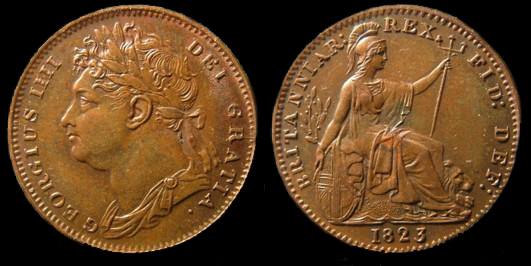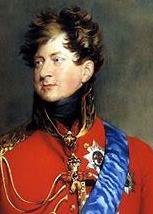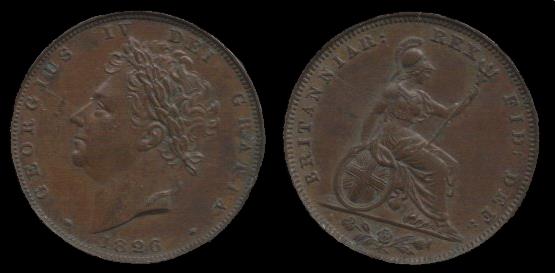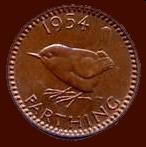








Designed by Nigel G Wilcox






The Paragon Of Metal Detecting
Powered By Sispro1
British Sterling Currency - Numismatics,
Farthing
For Reference ONLY
Everything For The Detectorist

George IV Farthing 1820-1830 AD
After the mint moved from the Tower of London to Tower Hill the production of gold and silver coins took precedence over copper in the Great Recoinage of 1816. The production of copper coins did not resume until the reign of King George IV (1820-1830), when farthings were produced in 1821. Benedetto Pistrucci was employed as a designer and engraver at the mint, and unfortunately for the farthing it was his job to engrave the designs for the new coinage, and he produced a spectacularly ugly portrait of the king, with a bulging face and neck. It is not difficult to see why the king was displeased with his portrait, and Pistrucci's treatment of Britannia on the obverse was not much better, with Britannia now facing right for the first time ever. Pistrucci was downgraded for refusing to copy another artist's work, and William Wyon was given the task of producing a better farthing, with the more flattering "bare head" type of 1826; however Wyon did not discard all Pistrucci's ideas, Britannia still faced right on the reverse. The George IV farthing was produced in two types, between 1821 and 1823, 1825, and 1826 it weighed 4.5-4.8 grams, with a diameter of 22 millimetres, and from 1826-1830 it weighed 4.6-4.9 grams with a diameter of 22 millimetres. Both Pistrucci's and Wyon's designs were produced in 1826. The Pistrucci obverse shows a left-facing bust of King George IV with the inscription GEORGIUS IIII DEI GRATIA, while the reverse shows a right-facing helmeted Britannia seated to the left of the coin, with a shield and trident, with the inscription BRITANNIAE REX FID DEF and the date in the exergue underneath Britannia. The Wyon obverse shows a left-facing laureated bust of King George IV with the inscription GEORGIUS IV DEI GRATIA date, while the reverse shows a right-facing centrally-seated helmeted Britannia with a shield and trident, with the inscription BRITANNIAE REX FID DEF. Wyon's preference was to put the date under the king's bust, and to put the rose, thistle, and shamrock in the exergue underneath Britannia.
The William IV (1830-1837) farthing, produced in 1831, and 1834-1837, continues the George IV design but with a right-facing bust of the new king, with the inscription GULIELMUS IIII DEI GRATIA date, while the reverse is identical to the previous reigns' Wyon design.
After the mint moved from the Tower of London to Tower Hill the production of gold and silver coins took precedence over copper in the Great Recoinage of 1816. The production of copper coins did not resume until the reign of King George IV (1820-1830), when farthings were produced in 1821. Benedetto Pistrucci was employed as a designer and engraver at the mint, and unfortunately for the farthing it was his job to engrave the designs for the new coinage, and he produced a spectacularly ugly portrait of the king, with a bulging face and neck. It is not difficult to see why the king was displeased with his portrait, and Pistrucci's treatment of Britannia on the obverse was not much better, with Britannia now facing right for the first time ever. Pistrucci was downgraded for refusing to copy another artist's work, and William Wyon was given the task of producing a better farthing, with the more flattering "bare head" type of 1826; however Wyon did not discard all Pistrucci's ideas, Britannia still faced right on the reverse. The George IV farthing was produced in two types, between 1821 and 1823, 1825, and 1826 it weighed 4.5-4.8 grams, with a diameter of 22 millimetres, and from 1826-1830 it weighed 4.6-4.9 grams with a diameter of 22 millimetres. Both Pistrucci's and Wyon's designs were produced in 1826. The Pistrucci obverse shows a left-facing bust of King George IV with the inscription GEORGIUS IIII DEI GRATIA, while the reverse shows a right-facing helmeted Britannia seated to the left of the coin, with a shield and trident, with the inscription BRITANNIAE REX FID DEF and the date in the exergue underneath Britannia. The Wyon obverse shows a left-facing laureated bust of King George IV with the inscription GEORGIUS IV DEI GRATIA date, while the reverse shows a right-facing centrally-seated helmeted Britannia with a shield and trident, with the inscription BRITANNIAE REX FID DEF. Wyon's preference was to put the date under the king's bust, and to put the rose, thistle, and shamrock in the exergue underneath Britannia.
The William IV (1830-1837) farthing, produced in 1831, and 1834-1837, continues the George IV design but with a right-facing bust of the new king, with the inscription GULIELMUS IIII DEI GRATIA date, while the reverse is identical to the previous reigns' Wyon design.
Royal Monarchy
Copyright © All Rights Reserved by Nigel G Wilcox · · E-Mail: ngwilcox100@gmail.com
INFORMATION - DATA
6. S.Menu
Pages

George IV
We do NOT buy or sell coins
Farthing

Main Coin Menu

VIEW ALL MENUS
Member NCMD
























